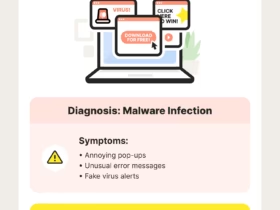Introduction: The Persistent Menace of Zeus Malware
Since its inception in 2007, Zeus malware (often called Zbot) has left a profound mark on cybersecurity across the globe. It’s among the most infamous examples of banking trojans, designed predominantly to steal sensitive online banking credentials and build massive botnets from compromised devices. While the original author was apprehended, the release of Zeus’s source code in 2011 shifted the landscape, spawning new variants that keep evolving and threat actors constantly finding new victims. In 2025, Zeus remains a top-tier cyber threat, targeting individuals, businesses, and even critical infrastructure with ever-more sophisticated attacks.
This guide offers a detailed, globally relevant resource about what Zeus malware is, how it spreads, its most notorious variants and attack techniques, and, most importantly, how to protect yourself and your organization.
How Zeus Infects: From Phishing to Black Hat SEO and Beyond
Phishing Campaigns:
Zeus’ most reliable weapon is social engineering—using fake emails or messages that look like they’re from trusted banks or companies. These lure users into clicking harmful links or opening malicious attachments that inject the Trojan into their system. Increasingly, text messages and messaging apps are being exploited for phishing.
Drive-By Downloads:
A single visit to a compromised website—sometimes even a legitimate site that’s been hacked—can lead to Zeus being quietly installed in the background, taking advantage of outdated browsers or plugins.
Black Hat SEO & Malicious Search Results:
Attackers use SEO manipulation so their malware-infected sites appear high on Google during trending events or crises. People searching for “urgent news” or “banking update” may inadvertently land on a trap.
Malvertising and Social Media:
Online ads and social media posts pointing to infected downloads have ramped up, and increasingly, cybercriminals prey on trending conversation topics.
Mobile & Cross-Platform Attacks:
Android and other mobile OS variants of Zeus specifically target banking apps by displaying fake overlays or intercepting SMS-based authentication codes, a serious problem as mobile banking surges worldwide.
Inside the Zeus Arsenal: Attack Mechanisms and Stealth Tactics
Zeus excels due to a range of stealthy, persistent capabilities:
- Man-in-the-Browser (MitB): Injects code into browsers (especially Windows/IE and sometimes Chrome/Firefox), modifying forms or transactions without user knowledge. It can silently change transfer destinations during online banking sessions.
- Keylogging: Records all keystrokes, logging everything from credit card numbers to security codes.
- Form Grabbing: Intercepts data entered into web forms—often before encryption is even applied.
- Webinjects: Alters webpage content in real time, displaying false balances or pages to cover up theft in progress.
- Peer-to-Peer Botnet Functionality: Latest variants create networks of infected machines that communicate without a central command, making takedown and detection far harder.
- Modular Design: Components can be added—like ransomware or DDoS modules—after initial infection.
Zeus Variants: From Gameover to Shylock
Over time, Zeus has evolved into a constellation of related threats. The table below summarizes key variants:
| Variant | Year(s) Active | Special Features | Typical Targets | Global Reach/Impact |
| Gameover Zeus | 2010–Present | Peer-to-peer botnet, ransomware loader | Financial institutions, consumers | $100M+ losses, global botnet, core of CryptoLocker |
| SpyEye | 2009–2014 | Hybrid with Zeus code, advanced evasion | Banks, finance | Europe, America, merged codebases |
| Ice IX | 2011–2014 | Aggressive webinjects, form grabbing | Global, banking | Targeted Middle East, East Europe |
| Carberp/Zberp | 2011–2015 | Designed for old Windows, hybridized | Russia, CIS, legacy systems | Regional fraud waves |
| Shylock | 2012–2016 | Self-updating, mosaic attacks | UK banks, Europe | Brexit-era surge, hard to contain |
| Android Zeus | 2016–Present | Overlay attacks, SMS theft | Mobile users | Rapid growth, Asia, Africa, Europe |
Attack Case Studies: Real-World Lessons
NASA Infiltration (2009):
Hackers used Zeus to gain illicit access to NASA’s internal networks, risking sensitive personnel and project data. Investigations led to system upgrades, but the attack marked the rise of state-grade banking trojans.
US & Global Banks:
Hundreds of financial organizations have weathered breaches involving Zeus. A major case involved coordinated fraud draining millions via man-in-the-browser and “mule” accounts across continents.
Gameover Zeus & CryptoLocker Ransomware:
In 2014, an international crime ring used Gameover Zeus to build a botnet infecting over 1 million computers. It acted as a conduit for CryptoLocker ransomware, which encrypted business data for ransom, causing more than $100M in damages.
The Global Botnet and Cybercrime Economy
Zeus is central to the modern cybercrime ecosystem:
- Peer-to-Peer Botnets: These decentralized networks make law enforcement takedowns substantially harder—the botnet can regenerate quickly through new “C2” nodes.
- Malware-as-a-Service: Dark web forums offer Zeus kits for rent or purchase, complete with user manuals and tech support in multiple languages.
- “Cybercrime Franchise Model”: Affiliates pay to launch mass campaigns targeting geographies or industries, and share profits with the malware developers.
Recognizing Zeus Infection: Key Signs
| Symptom | What to Check/Do |
| Slow PC/smartphone, frequent crashes | Unusual Resource Use; Task Manager review |
| Strange or unknown processes in the background | Security software scan, process viewer |
| Random pop-ups, unusual browser behavior | Check browser extensions, run anti-malware |
| Unauthorized bank/account changes | Contact your bank, change credentials |
| Security tool alerts or network anomalies | Investigate immediately, disconnect device |
How to Prevent Infection and Detect Zeus (2025 Best Practices)
For Individuals
- Use reputable antivirus and enable real-time scanning
- Be suspicious of all links and attachments, even from familiar sources
- Set up two-factor (preferably app-based, not SMS) authentication on all sensitive accounts
- Regularly back up data offline
- Patch/update all devices and browsers immediately
For Businesses
- Deploy advanced EDR/XDR for threat hunting and fast response
- Continually train staff to recognize phishing/social engineering
- Segment networks and enforce least-privilege principles
- Practice rapid incident response procedures (regular tabletop drills)
- Subscribe to threat intelligence feeds for early warnings about targeted campaigns
Incident Response: If You Suspect Infection
- Isolate the affected device(s) from your network.
- Scan with specialized anti-Zeus tools from reputable vendors.
- Reset all online banking and critical service passwords from a clean machine.
- Notify your bank/IT department; monitor for fraudulent activity.
- Backup & Restore: Restore from safe backups if compromise is confirmed.
- Consult with cybersecurity professionals for deep remediation and future-proofing.
FAQs: What People Also Ask about Zeus Malware
What makes Gameover Zeus different from regular Zeus?
Gameover Zeus uses a decentralized peer-to-peer system, making it much harder for law enforcement to disrupt, and it often delivers ransomware (CryptoLocker).
Can Zeus infect my mobile device?
Yes, Android-specific Zeus variants can steal banking details and intercept SMS authentication codes, especially if you install apps from unofficial sources.
How do I know if I’m infected with Zeus?
Watch for slowdowns, strange browser errors, unauthorized financial transactions, or security alerts. Advanced Zeus can stay dormant, so regular scanning is key.
What is a webinject?
Webinjects are code snippets injected into your browser, altering what you see—like a fake bank login page—allowing hackers to steal credentials without your knowledge.
Is Zeus malware still a threat in 2025?
Absolutely! While original variants have shifted, Zeus’s descendants remain active and adapt quickly to new attack methods and security trends.
Conclusion: Secure Your Digital Life Against Zeus
Zeus’s evolution from a banking trojan to a global cybercrime phenomenon demonstrates the importance of multi-layered, proactive cybersecurity. Regular software updates, security education, vigilance, and advanced threat defense tools are non-negotiable in the ongoing fight against Zeus.
Businesses must invest in next-generation endpoint protection, employee training, and rapid detection/response capabilities. Individual users must practice safe digital habits, update all apps, and remain skeptical of unsolicited messages.
By staying informed, adopting robust defenses, and responding swiftly to incidents, you can safeguard your finances, data, and peace of mind, even as Zeus malware’s tactics continue to evolve worldwide.












Leave a Reply
View Comments